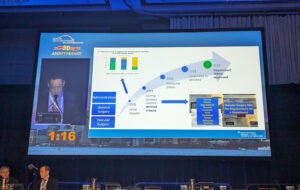
A 14-year effort to achieve departmental status for vascular surgery at a large healthcare system in Southern California resulted in significant gains for the specialty within the organizational apparatus, according to an administrative case report on an effort finalized last year.
Jeffrey Hsu, MD, the regional chief of vascular surgery at Kaiser Permanente Southern California, charted the course of departmentalization at his institution amid resistance from general surgery and organization-level bylaw changes necessary to define a transition process during a 2023 VEITHsymposium (Nov. 14–18) session in New York City.
The process originated after a general consensus was reached among the healthcare system’s vascular surgeons in 2008 that they needed their own department due to issues around inadequate representation for the specialty, lack of administrative control over vascular surgery resources, and “a general sense of recognition and identity for the specialty,” Hsu told attendees.
After changes to the Kaiser Permanente bylaws were defined and approved, it became apparent vascular surgery met all the criteria required to become a department.
“In 2016, vascular surgery was granted divisional status by the executive leadership,” explained Hsu. “However. operationally this had little effect, and the majority of vascular surgery chiefs wanted to continue to pursue department status. In 2017, vascular surgeons in our organization collectively decided to transition from a division to a department. Through a lengthy process of negotiations and discussions, we were finally able to achieve in unanimity. In 2021, we were able to gain the support of the general surgery department to proceed.”
Finally, in 2022, the Kaiser Permanente board of directors “unanimously voted to form the department of vascular surgery,” added Hsu.
The stakes couldn’t be higher, he observed.
“It stands to reason that specialty representation at all levels of healthcare organizations will become increasingly important as we move toward value-based systems, increased administration and more corporate control of healthcare,” Hsu said. “Vascular surgery’s place in the organizational structure is an important factor to consider.”
He listed the benefits witnessed in the year since the department was formed. Surgical service line operations now include vascular surgery decision-making, Hsu said. Collegiality with general surgery “remains strong and unharmed,” and “the medical school has established vascular surgery clerkships and appointed vascular surgery preceptors.” Surgical residents are given increased exposure and longer rotations in vascular surgery, and vascular surgery chiefs are now invited to all surgical leadership meetings, both regionally and locally, Hsu added.
“This report demonstrates that departmentalization of vascular surgery is possible in large healthcare organization,” he concluded. “So I ask our colleagues who take leadership positions in your organizations who are faced with mounting administrative challenges—it is my hope that you will consider departmentalization as a viable option.”











